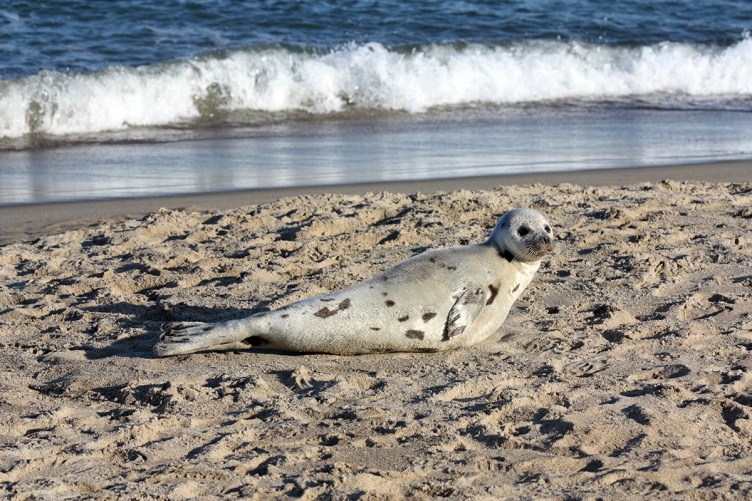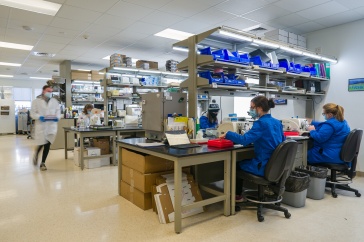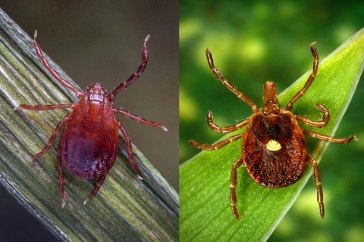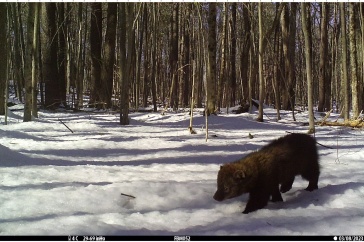
Harp seals like this one are born on pack ice in the arctic and Canadian Provinces and sometimes migrate to the East Coast during winter.
The New Hampshire Veterinary Diagnostic Lab at the University of New Hampshire has partnered with Seacoast Science Center Marine Mammal Rescue to help diagnose the cause of deaths of marine mammals found on the Northern New England seacoast.
“We are so pleased to have partnered with the NH Veterinary Diagnostic Lab at UNH for diagnostic and necropsy services for marine mammal cases,” said Seacoast Science Center Marine Mammal Rescue Manager Ashley Stokes. “Prior to the partnership, specimens were sent to the New England Aquarium facility in Quincy, Mass. Having access to NHVDL/UNH will ensure quick and accurate diagnostics when NEAq’s facility is at capacity or unable to take carcasses during sea turtle rescue season.”
According to Inga Sidor, senior veterinary pathologist with the NH Veterinary Diagnostic Lab, while the lab’s primary responsibility is to agricultural veterinary clients, as part of the NH Department of Agriculture, Markets, Food, and ongoing relationships with domestic animal veterinarians, the lab has expanded into significant work in wildlife species over the last decade. This includes being members of the Northeast Wildlife Disease Cooperative, working with regional state fish and game agencies to leverage the lab’s expertise in wildlife disease to assist in surveillance and management of diverse wildlife populations.
“This work supports our emphasis on the concept of One Health, recognizing that human, wild and domestic animal, and ecosystem health are interdependent. This partnership with Seacoast Science Center formalizes our involvement with monitoring health and disease in Gulf of Maine marine mammal species,” said Sidor, who has extensive experience in the field of marine mammal stranding and pathology.
The New Hampshire Veterinary Diagnostic Lab recently took its first case from Seacoast Science Center Marine Mammal Rescue. On Monday, Nov. 26, Marine Mammal Rescue received a report of a seal on the beach in Rye. The juvenile male harp seal was alive, but not responsive. After taking him off the beach to conduct further health assessment, the seal died.
The seal was taken to UNH in Durham for a necropsy. The seal was examined and tested for phocine distemper virus, which was responsible for the seal die-off this year on the Northeast coast.
“This summer the coast of the Gulf of Maine saw a dramatic increase in harbor and gray seal mortality, with more than 1,400 seals found stranded from Virginia to the Canadian border but primarily clustered in the New England area. Preliminary indications are that these deaths are attributable to phocine distemper virus, which is a virus that circulates within seal populations. This virus is highly infectious and easily spread nose-to-nose among seals, in the same family as measles and canine distemper virus but cannot be transmitted to humans. A prior, smaller epizootic in this region in 2011 was caused by avian influenza virus and a previous outbreak of phocine distemper virus occurred in 2006,” Sidor said.
“The case investigation is ongoing, but preliminary test results were negative for viral infection, suggesting something else may have caused this seal’s death. It was an unusually robust juvenile animal compared to the more typical very skinny late-fall pups we see who are having trouble making a living in the harsh environment of the ocean. An animal in good body condition immediately suggests a different set of causes. If we can rule out infection, acute toxicity as the result of harmful algal blooms might also be considered,” she said.
Mortality in marine mammals may be caused by a broad range of factors, including nutritional/environmental factors, entanglements and other human-related trauma, predators, as well as a variety of infectious agents, Sidor said. In seals in this region, disease can be one primary cause of stranding. While many infections are sporadic, experts do see occasional epizootics -- sudden, increased mortality of an infectious cause in animals -- of viral infections.
According to Seacoast Science Center Marine Mammal Rescue, this is the time of year that New Hampshire starts to see ice seals on its coast. Harp and hooded seals are born on pack ice in the arctic and Canadian Provinces and sometimes migrate to the East Coast during winter. Other seals seen in New England’s coastal region are harbor, gray, and hooded seals. It is normal behavior for seals to haul out onto the beach to rest. Whales, porpoise, and dolphins frequent the Gulf of Maine, but rarely strand on the beach.
Seacoast Science Center Marine Mammal Rescue is one of 15 members of the Greater Atlantic Regional Stranding Network (servicing Maine to Virginia) overseen by NOAA Fisheries. The data collected by all partner organizations is reported to the Marine Mammal Health and Stranding Response Program National Database and used by scientists for a variety of reasons, such as to monitor populations and their health, visualize trends, track human interaction, and understand spread of disease.
Anyone who finds any marine mammal, live or dead, on the beach should call the Seacoast Science Center Marine Mammal Rescue hotline at 603-997-9448.
New Hampshire Veterinary Diagnostic Lab is co-managed by the New Hampshire Department of Agriculture, Markets & Food and the New Hampshire Agricultural Experiment Station. Since 1970, the lab has provided accessible, timely and accurate diagnostic services for the New Hampshire Department of Agriculture, Markets, & Food, New Hampshire Department of Health and Human Services, New Hampshire Fish and Game Department, state and local law enforcement agencies, veterinarians, farmers, state, regional, and federal agencies, and individuals.
Founded in 1887, the NH Agricultural Experiment Station at the UNH College of Life Sciences and Agriculture is UNH’s original research center and an elemental component of New Hampshire's land-grant university heritage and mission. We steward federal and state funding, including support from the USDA National Institute of Food and Agriculture, to provide unbiased and objective research concerning diverse aspects of sustainable agriculture and foods, aquaculture, forest management, and related wildlife, natural resources and rural community topics. We maintain the Woodman and Kingman agronomy and horticultural research farms, the Macfarlane Research Greenhouses, the Fairchild Dairy Teaching and Research Center, and the Organic Dairy Research Farm. Additional properties also provide forage, forests and woodlands in direct support to research, teaching, and outreach.
-
Written By:
Lori Tyler Gula, PhD | NH Agricultural Experiment Station | lori.gula@unh.edu | 603-862-1452



















































